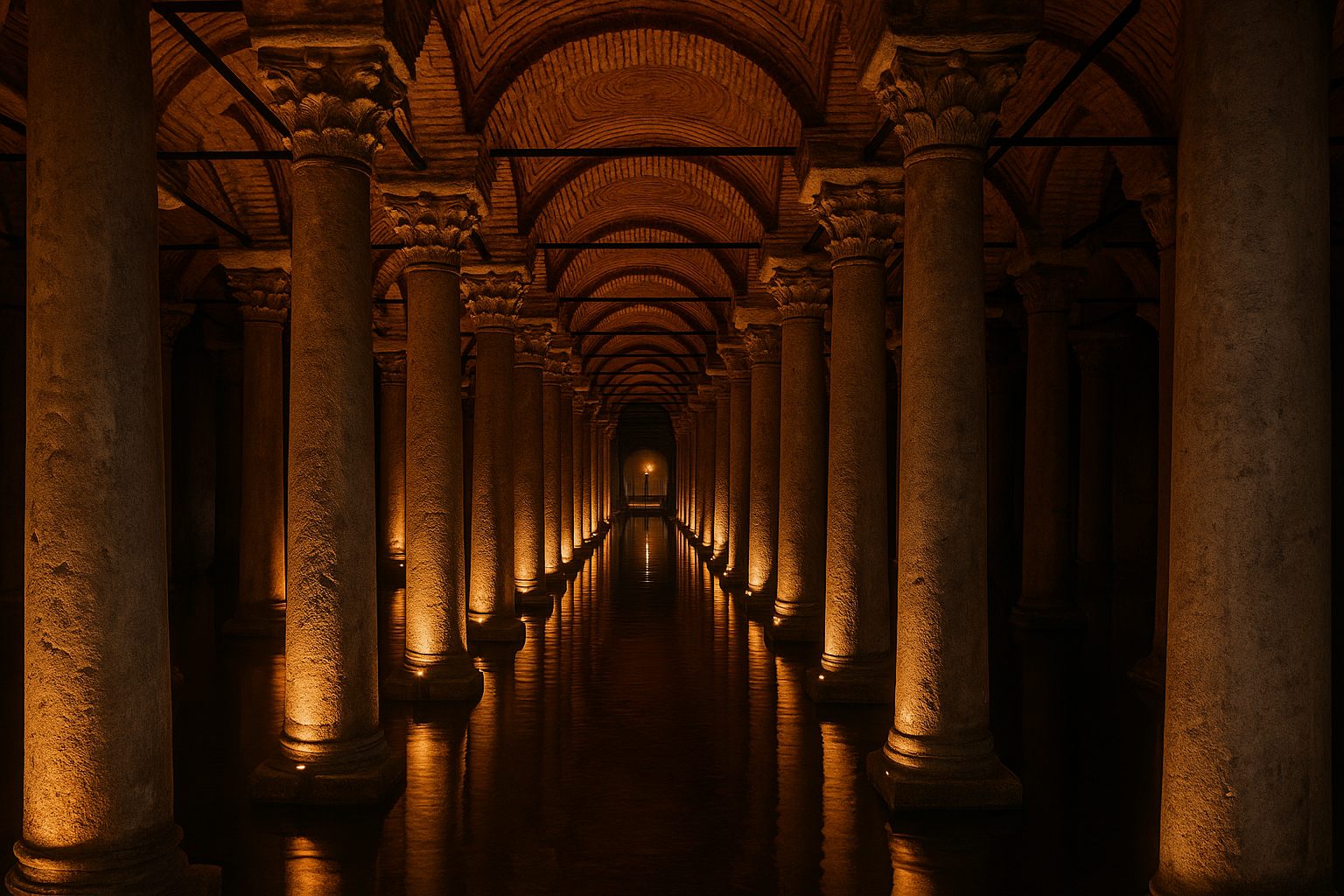
Yerebatan Sarnıcı (Basilica Cistern)
HISTORICAL BACKGROUND AND SIGNIFICANCE
Yerebatan Sarnıcı, commonly known as the Basilica Cistern, is one of the most remarkable remnants of Byzantine architecture in Istanbul. Constructed during the reign of Emperor Justinian I in the 6th century (specifically between 532 and 537 AD), this vast underground water reservoir was built to supply water to the Great Palace of Constantinople and later to the Topkapi Palace. The cistern is a testament to the engineering prowess of the Byzantine Empire, showcasing their ability to create functional yet grand structures.
The name 'Basilica Cistern' derives from the nearby Stoa Basilica, a large public square that once stood above it. The cistern was rediscovered in 1545 by the French scholar Pierre Gilles, and since then, it has fascinated visitors with its historical significance and architectural beauty. It is estimated that the cistern could hold up to 100,000 tons of water, making it one of the largest of its kind in the city.
ARCHITECTURAL FEATURES AND DESIGN ELEMENTS
The Basilica Cistern spans an impressive area of approximately 9,800 square meters and is supported by 336 marble columns, each standing 9 meters tall. These columns are arranged in 12 rows of 28 columns each, creating a mesmerizing forest-like effect. The columns are adorned with various capitals, showcasing different styles, including Corinthian and Ionic, which reflect the architectural influences of the time.
One of the most striking features of the cistern is its intricate design, which includes vaulted ceilings that were constructed using a technique known as 'cross vaulting.' This method not only provided structural integrity but also allowed for the creation of a visually stunning space illuminated by the soft glow of ambient light. The cistern is also home to two iconic Medusa heads, which serve as column bases. The origins of these heads remain a mystery, adding to the allure of the site.
CULTURAL AND RELIGIOUS IMPORTANCE
The Basilica Cistern holds significant cultural and religious importance in Istanbul's history. It served as a vital water source for the Byzantine emperors and later for the Ottoman sultans, symbolizing the city's resilience and ingenuity in overcoming the challenges of urban life. The cistern also reflects the fusion of Roman engineering techniques with Byzantine artistry, showcasing the cultural exchange that characterized the region.
In addition to its practical use, the cistern has inspired countless legends and stories throughout the centuries. It has been featured in literature, art, and even films, further embedding it in the cultural consciousness of Istanbul. The atmosphere of the cistern, with its dim lighting and echoing water, evokes a sense of mystery and reverence, making it a place of reflection and contemplation.
VISITOR EXPERIENCE AND WHAT TO EXPECT
Visiting Yerebatan Sarnıcı is a unique experience that transports you back in time. As you descend the staircase into the cool, dark space, you are greeted by the sight of the vast underground chamber filled with water. The sound of dripping water echoes throughout the cistern, creating an otherworldly ambiance.
Visitors can stroll along the raised walkways that allow for a closer view of the columns and the water below. The cistern is illuminated with soft lighting, highlighting the architectural details and creating a serene atmosphere. Along the way, you can find informational displays that provide insights into the history and significance of the cistern, enhancing your understanding of this remarkable site.
INTERESTING FACTS AND ANECDOTES
1. The Basilica Cistern has appeared in various films and novels, most notably in the James Bond movie 'From Russia with Love,' where it served as a dramatic backdrop for a chase scene. 2. The cistern is home to a variety of fish, which have adapted to the underground environment. Visitors often enjoy spotting these fish swimming in the water. 3. The Medusa heads, which are a significant feature of the cistern, are believed to have been repurposed from earlier Roman structures, showcasing the recycling of materials in Byzantine architecture. 4. The cistern was once a gathering place for locals who would come to collect water, making it a social hub in addition to its functional role.
PRACTICAL VISITING INFORMATION
- **Hours of Operation**: The Basilica Cistern is open to visitors daily from 9:00 AM to 5:30 PM. However, during the summer months, it may stay open until 7:00 PM, so it's advisable to check the official website for the latest information. - **Best Times to Visit**: To avoid large crowds, it is recommended to visit early in the morning or later in the afternoon. Weekdays tend to be less busy than weekends. - **Tips for Visitors**: Wear comfortable shoes as you will be walking on raised walkways. Bring a light jacket, as the temperature inside the cistern can be cooler than outside. Don't forget your camera; the unique lighting and architecture provide excellent photo opportunities.
In conclusion, Yerebatan Sarnıcı is not just an architectural marvel but also a significant piece of Istanbul's history that continues to captivate visitors from around the world. Whether you are an architecture enthusiast, a history buff, or simply looking for a unique experience, the Basilica Cistern is a must-visit destination that offers a glimpse into the city's rich past.